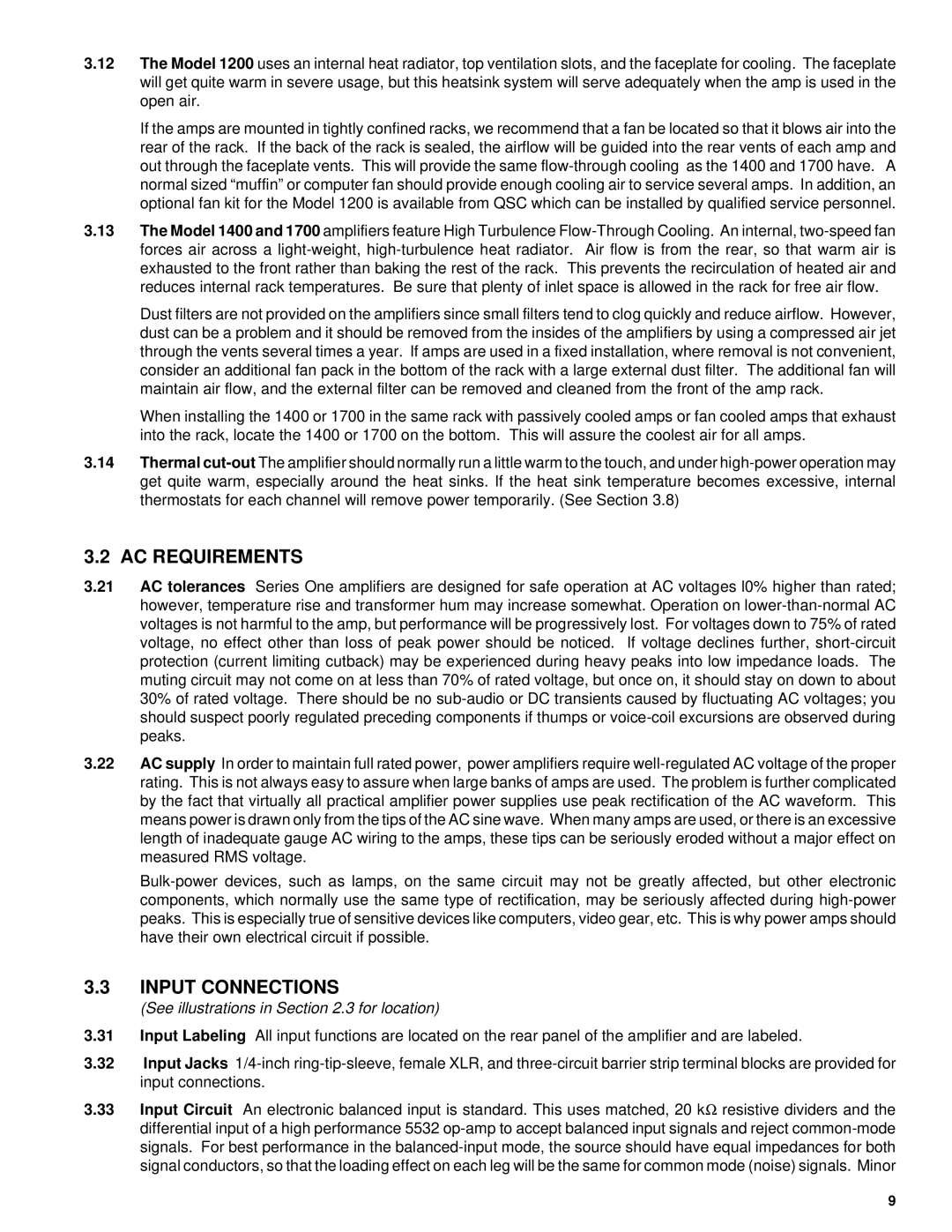3.12The Model 1200 uses an internal heat radiator, top ventilation slots, and the faceplate for cooling. The faceplate will get quite warm in severe usage, but this heatsink system will serve adequately when the amp is used in the open air.
If the amps are mounted in tightly confined racks, we recommend that a fan be located so that it blows air into the rear of the rack. If the back of the rack is sealed, the airflow will be guided into the rear vents of each amp and out through the faceplate vents. This will provide the same flow-through cooling as the 1400 and 1700 have. A normal sized “muffin” or computer fan should provide enough cooling air to service several amps. In addition, an optional fan kit for the Model 1200 is available from QSC which can be installed by qualified service personnel.
3.13The Model 1400 and 1700 amplifiers feature High Turbulence Flow-Through Cooling. An internal, two-speed fan forces air across a light-weight, high-turbulence heat radiator. Air flow is from the rear, so that warm air is exhausted to the front rather than baking the rest of the rack. This prevents the recirculation of heated air and reduces internal rack temperatures. Be sure that plenty of inlet space is allowed in the rack for free air flow.
Dust filters are not provided on the amplifiers since small filters tend to clog quickly and reduce airflow. However, dust can be a problem and it should be removed from the insides of the amplifiers by using a compressed air jet through the vents several times a year. If amps are used in a fixed installation, where removal is not convenient, consider an additional fan pack in the bottom of the rack with a large external dust filter. The additional fan will maintain air flow, and the external filter can be removed and cleaned from the front of the amp rack.
When installing the 1400 or 1700 in the same rack with passively cooled amps or fan cooled amps that exhaust into the rack, locate the 1400 or 1700 on the bottom. This will assure the coolest air for all amps.
3.14Thermal cut-outThe amplifier should normally run a little warm to the touch, and under high-power operation may get quite warm, especially around the heat sinks. If the heat sink temperature becomes excessive, internal thermostats for each channel will remove power temporarily. (See Section 3.8)
3.2 AC REQUIREMENTS
3.21AC tolerances Series One amplifiers are designed for safe operation at AC voltages l0% higher than rated; however, temperature rise and transformer hum may increase somewhat. Operation on lower-than-normal AC voltages is not harmful to the amp, but performance will be progressively lost. For voltages down to 75% of rated voltage, no effect other than loss of peak power should be noticed. If voltage declines further, short-circuit protection (current limiting cutback) may be experienced during heavy peaks into low impedance loads. The muting circuit may not come on at less than 70% of rated voltage, but once on, it should stay on down to about 30% of rated voltage. There should be no sub-audio or DC transients caused by fluctuating AC voltages; you should suspect poorly regulated preceding components if thumps or voice-coil excursions are observed during peaks.
3.22AC supply In order to maintain full rated power, power amplifiers require well-regulated AC voltage of the proper rating. This is not always easy to assure when large banks of amps are used. The problem is further complicated by the fact that virtually all practical amplifier power supplies use peak rectification of the AC waveform. This means power is drawn only from the tips of the AC sine wave. When many amps are used, or there is an excessive length of inadequate gauge AC wiring to the amps, these tips can be seriously eroded without a major effect on measured RMS voltage.
Bulk-power devices, such as lamps, on the same circuit may not be greatly affected, but other electronic components, which normally use the same type of rectification, may be seriously affected during high-power peaks. This is especially true of sensitive devices like computers, video gear, etc. This is why power amps should have their own electrical circuit if possible.
3.3INPUT CONNECTIONS
(See illustrations in Section 2.3 for location)
3.31Input Labeling All input functions are located on the rear panel of the amplifier and are labeled.
3.32Input Jacks 1/4-inch ring-tip-sleeve, female XLR, and three-circuit barrier strip terminal blocks are provided for input connections.
3.33Input Circuit An electronic balanced input is standard. This uses matched, 20 kΩ resistive dividers and the differential input of a high performance 5532 op-amp to accept balanced input signals and reject common-mode signals. For best performance in the balanced-input mode, the source should have equal impedances for both signal conductors, so that the loading effect on each leg will be the same for common mode (noise) signals. Minor
